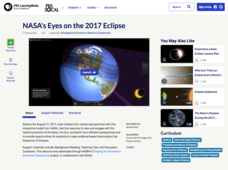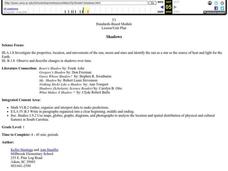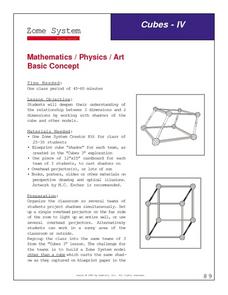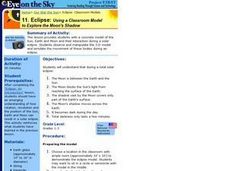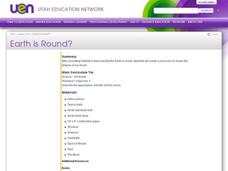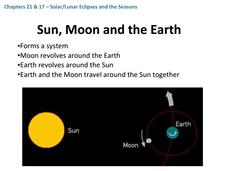PBS
NASA's Eyes on the 2017 Eclipse
How did the 2017 eclipse look in Los Angeles—or Chicago? Experience both views, plus many more, using a lesson from PBS's Space series for middle schoolers. Scholars follow the movements of the sun, moon, and Earth during the most recent...
Curated OER
Studying Shadows
Young scholars measure shadows and explore the altitude of the sun. In this sun lesson students will graph the length of shadows and solar altitude against time.
Curated OER
Shadows
First graders measure how a shadow changes over the course of a day. They write about what they would do if they lost their shadow, and make silhouettes of themselves. Students make up a shadow dance and read stories about shadows.
Curated OER
Moon Shadows
For this moon shadows worksheet, 3rd graders follow the directions to set up a demonstration about the sun, the earth and the moon.
Curated OER
Sundials
Students investigate the different types of sundials and their history. In this shadows and time of day lesson students build their own sundials.
Curated OER
Individual Sundial (Cloud/Rain Activity)
Students make a simple sundial to examine the changes in shadows over time. In this sundial and shadow instructional activity, students make a simple sundial out of a manila folder and pencil. They observe how shadows change over time,...
Curated OER
Tracking and Tracing Sunspots
Learners examine sunspots. In this sunspot lesson, students use applets to investigate the movement of sunspots. Learners research sunspots and evaluate the rotation of the sun. Lesson references outside resources not available in this...
Curated OER
Cubes-IV
Students examine the relationship between three dimensions and two dimensions by working with shadows of cubes and other models. Students work in groups and use Zome System Creator Kits to try and build a shape other than a cube that...
Curated OER
Moon Phases, Day/Night
Fifth graders observe a demonstration that shows how the alignment of the sun, moon, earth relate to the phases of the moon that occur each month. They describe the moon's phases after experimenting in a small group setting and recording...
Curated OER
Reasons for Seasons
Young scholars investigate a model of the tilt of the Earth in its relationship to the Sun during the different seasons of the year. They study the solstices and equinoxes, while determining how sunlight hits the Earth with different...
Curated OER
Hello, Sunshine!
Middle schoolers investigate how the sun travels across the sky at different latitudes using Solar Motion Demonstrator. In this earth science instructional activity, students explain why seasons change. They study how the tilt of the...
Curated OER
Sun Shadow Cycles
High schoolers use diagrams to review how the Earth rotates around the sun. In groups, they use the same diagrams to explain how the sun shadows are produced and how they differ between seasons. They describe the Earth's rotation and...
Curated OER
Eclipse: Using a Classroom Model to Explore the Moon's Shadow
Learners manipulate and observe a 3-D model which simulates the activity of the Sun, Earth and Moon during a solar eclipse.
Curated OER
Sun Path: Interactive On-line Mac or PC
Students use SunPath in the yearly mode to investigate seasonal changes in sunrise, sunset, length of day and sun altitude at their own latitude. Sun Path JAVA applet uses equations for a spherical Earth to calculate the sunrise and...
Curated OER
Shadow Matching
Students pair up with a partner and find a good self space. They choose who "match" who first (i.e., be the "leader"). Standing next to their partner, and only looking at their shadow, each student tries to match their partner
Curated OER
Shadow Trackers
Students use online websites to inquire about the cycle of day and night. In this web based lesson, students are able to see the movement of the sun and Earth. Students can look at different parts of the Earth as if they were on the Sun...
Curated OER
Earth, Moon, and Sun
In this earth, moon, and sun orbits worksheets, students will read the cause of four different events that focus on the earth's rotation around the sun and the moon's rotation around the earth. Then students will write in the effect of...
Curated OER
Making a Sundial
Third graders make a sundial and explain how to use it. They describe the movement of Earth and the moon and the apparent movement of other bodies through the sky. They predict what happens when they put their sundials in the sun.
Curated OER
LRO Sees Apollo 11 on the Moon!
In this moon image learning exercise, students determine the scale of an image taken by the LRO satellite of the Apollo 11 landing site. Students calculate the sun's angle at the time of the photograph using the shadow of the Lunar...
Curated OER
Sundials and Shadows - What Can They Teach Us About Seasons?
Pupils collect and analyze data relating to seasonal changes. They view a video, research web sites and build a sundial to collect their data.
Curated OER
Time
Students make a sundial. For this time lesson, students determine the time of the day by creating a sundial. They check the time on the sundial, hourly, for one week. Afterward, they explore what happened to the shadows in reference to...
Curated OER
Earth is Round?
Third graders discuss how Aristotle concluded that the Earth was round. As a class, they review theories about the Earth's shape and describe how life on Earth would be different if it were flat. Individually, they make a moon book in...
Curated OER
Tides, Eclipses, Day and Night, and Seasons
For this earth science worksheet, students use the clues given at the bottom of the sheet to complete the crossword puzzle on tides, eclipses, day and night, and the seasons of the year. There are 17 clues to solve in the puzzle.
Curated OER
Solar/Lunar Eclipses and the Seasons
How do the moon, sun, and Earth line up to create eclipses? Why do the seasons change throughout a year? The answers to these questions are explained through this series of slides. This apt presentation outlines information using bullet...


